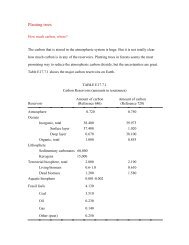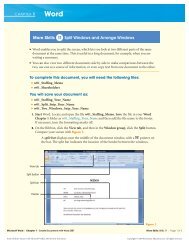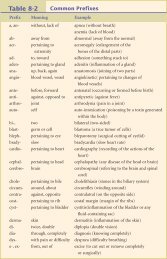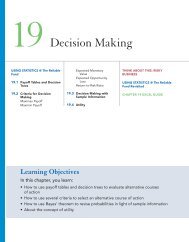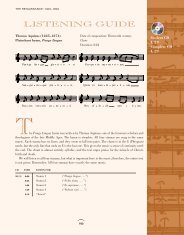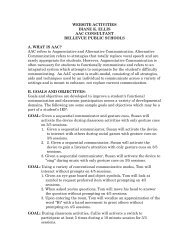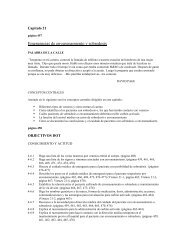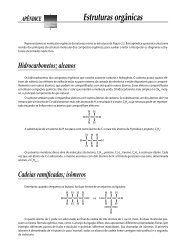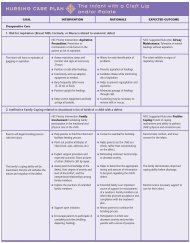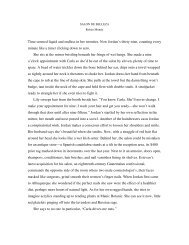chapter
chapter
chapter
You also want an ePaper? Increase the reach of your titles
YUMPU automatically turns print PDFs into web optimized ePapers that Google loves.
Apparent polar<br />
Apparent polar<br />
wandering<br />
wandering path for<br />
path for Eurasia 500 m.y. North America<br />
500 m.y.<br />
400 m.y.<br />
400 m.y.<br />
300 m.y. 300 m.y.<br />
A.<br />
North<br />
America<br />
Apparent polar<br />
wandering<br />
path for Eurasia<br />
B.<br />
North<br />
America<br />
200 m.y.<br />
100 m.y.<br />
200 m.y.<br />
100 m.y.<br />
Eurasia<br />
Africa<br />
Africa<br />
Eurasia<br />
Apparent polar<br />
wandering<br />
path for North<br />
America<br />
Figure 7.17 Simplified apparent polar wandering paths as<br />
established from North American and Eurasian paleomagnetic<br />
data. A. The more westerly path determined from North<br />
American data is thought to have been caused by the westward<br />
drift of North America by about 24 degrees from Eurasia. B. The<br />
positions of the wandering paths when the landmasses are<br />
reassembled in their predrift locations.<br />
separated continents are placed next to one another, as<br />
we now believe they were prior to the opening of the<br />
Atlantic Ocean (Figure 7.17B).<br />
Magnetic Reversals and Seafloor Spreading. Another<br />
discovery came when geophysicists learned that Earth’s<br />
magnetic field periodically reverses polarity; that is, the<br />
north magnetic pole becomes the south magnetic pole,<br />
Chapter 7 Plate Tectonics 213<br />
and vice versa. A rock solidifying during one of the<br />
periods of reverse polarity will be magnetized with the<br />
polarity opposite that of rocks being formed today.<br />
When rocks exhibit the same magnetism as the present<br />
magnetic field, they are said to possess normal polarity,<br />
whereas those rocks exhibiting the opposite<br />
magnetism are said to have reverse polarity. Evidence<br />
for magnetic reversals was obtained from lavas and sediments<br />
from around the world.<br />
Once the concept of magnetic reversals was confirmed,<br />
researchers set out to establish a time scale for<br />
polarity reversals. Many areas exist where volcanic activity<br />
has occurred sporadically for periods of millions<br />
of years (Figure 7.18). The task was to measure the directions<br />
of paleomagnetism in numerous lava flows of<br />
various ages. These data were collected from several<br />
places and were used to determine the dates when the<br />
polarity of Earth’s magnetic field changed. Figure 7.19<br />
shows the time scale of the polarity reversals established<br />
for the last few million years.<br />
A significant relationship was uncovered between<br />
the magnetic reversals and the seafloor-spreading hypothesis.<br />
Very sensitive instruments called magnetometers<br />
were towed by research vessels across a segment of<br />
the ocean floor located off the West Coast of the United<br />
States. Here workers from the Scripps Institute of<br />
Oceanography discovered alternating strips of highand<br />
low-intensity magnetism that trended in roughly<br />
a north-south direction. This relatively simple pattern of<br />
magnetic variation defied explanation until 1963, when<br />
it was tied to the concept of seafloor spreading. The<br />
strips of high-intensity magnetism are regions where<br />
the paleomagnetism of the ocean crust is of the normal<br />
type. Consequently, these positively magnetized rocks<br />
enhance the existing magnetic field. Conversely, the lowintensity<br />
strips represent regions where the ocean crust<br />
is polarized in the reverse direction and, therefore, weaken<br />
the existing magnetic field. But how do parallel strips<br />
of normally and reversely magnetized rock become distributed<br />
across the ocean floor?<br />
As new basalt is added to the ocean floor at the<br />
oceanic ridges, it becomes magnetized according to the<br />
existing magnetic field (Figure 7.20). Because new rock<br />
is added in approximately equal amounts to the trailing<br />
edges of both plates, we should expect strips of equal<br />
size and polarity to parallel both sides of the ocean<br />
ridges, as shown in Figure 7.20. This explanation of the<br />
alternating strips of normal and reverse polarity, which<br />
lay as mirror images across the ocean ridges, was the<br />
strongest evidence so far presented in support of the<br />
concept of seafloor spreading.<br />
Now that the dates of the most recent magnetic reversals<br />
have been established, the rate at which spreading<br />
occurs at the various ridges can be determined<br />
accurately. In the Pacific Ocean, for example, the magnetic<br />
strips are much wider for corresponding time intervals<br />
than those of the Atlantic Ocean. Hence, we




